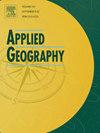基于多源数据和可解释性机器学习的西南地区贫困发生的时空格局与机制
IF 4
2区 地球科学
Q1 GEOGRAPHY
引用次数: 0
摘要
中国的扶贫实践在全球范围内脱颖而出,但由于数据和方法的碎片化,对其复杂过程进行有启发性的解读仍然具有挑战性。本研究提出了一个结合多源数据融合、集成学习和可解释机器学习的集成分析框架。通过将多维社会经济调查(SES)数据与时空连续夜间灯光(NTL)观测相结合,该框架能够在数据丰富和数据稀缺的背景下实现可靠的贫困预测和机制洞察。将该方法应用于西南云贵桂地区的减贫动态研究。在328个县级单位中,平均贫困率从33.38%显著下降到12.42%(2000-2019年),呈现出普遍高贫困率(2000-2005年)、不均衡区域改善(2006-2012年)和变革性减贫(2013-2019年)三个阶段的特征。时空分析揭示了贫困从高度聚集到更分散分布的转变。通过可解释的机器学习,该研究分析了三类24个驱动因素。而经济& &;人口指标日益占主导地位,地理因素的影响持续存在。环境和社会;基础设施指标强调了对治理贫困采取综合办法的必要性。该研究为中国的后扶贫时代提供了启示,同时为全球可持续发展框架下的包容性增长做出了贡献。本文章由计算机程序翻译,如有差异,请以英文原文为准。
Unveiling the Spatio-Temporal Patterns and mechanisms of poverty incidence in Southwest China through multi-sourced data and interpretable machine learning
China's poverty alleviation practice stands out globally, yet illuminatingly decoding its complex process remains challenging due to data and method fragmentation. This study proposed an integrated analytical framework combining multi-source data fusion, ensemble learning, and interpretable machine learning. By integrating multi-dimensional socioeconomic survey (SES) data with spatiotemporally continuous nighttime light (NTL) observations, the framework enables robust poverty prediction and mechanistic insights in data-rich and data-scarce contexts. The method was applied to examine poverty reduction dynamics in Yunnan-Guizhou-Guangxi area (YGGA) of Southwest China. Across 328 county-level units, the average poverty incidence markedly decreased from 33.38% to 12.42% (2000–2019), characterized by three phases: widespread high poverty (2000–2005), uneven regional improvement (2006–2012), and transformative poverty reduction (2013–2019). Spatio-temporal analysis uncovered the transformation from highly clustered poverty to a more dispersed distribution. Through interpretable machine learning, the study analyzed 24 driving factors in three categories. While economic & demographic indicators became increasingly dominant, the persistent influence of geographical & environmental, and social & infrastructure indicators underscored the necessity for an integrated approach to poverty governance. This study provided insights for China's post-poverty alleviation era while contributing towards inclusive growth within global sustainable development framework.
求助全文
通过发布文献求助,成功后即可免费获取论文全文。
去求助
来源期刊

Applied Geography
GEOGRAPHY-
CiteScore
8.00
自引率
2.00%
发文量
134
期刊介绍:
Applied Geography is a journal devoted to the publication of research which utilizes geographic approaches (human, physical, nature-society and GIScience) to resolve human problems that have a spatial dimension. These problems may be related to the assessment, management and allocation of the world physical and/or human resources. The underlying rationale of the journal is that only through a clear understanding of the relevant societal, physical, and coupled natural-humans systems can we resolve such problems. Papers are invited on any theme involving the application of geographical theory and methodology in the resolution of human problems.
 求助内容:
求助内容: 应助结果提醒方式:
应助结果提醒方式:


